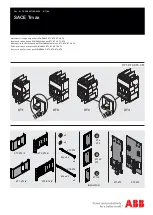
CB Watch 3 User Manual
v6.3 - May 2019
Page 39 of 100
The gas sensor records the
“absolute” value of the pressure inside the gas chamber
and
outputs it digitally in bar. This is what is shown in the HMI for metric units. If there is a
gauge on the system, the gauge may
show a “gauge pressure” (or
pressure relative to
atmospheric pressure) which is the difference between the absolute pressure measured
and the atmospheric pressure at this altitude/temperature. Users will then experience a
difference between the two readings of approximately 1 bar or 100 kPa (or 14.7 psi) .
Warning:
Therefore take care when looking at the data or setting alarm limits. All
metric
pressures used in the CBW3 are “absolute” pressures in bar
The imperial unit output is different than for metric units. It is in psig (psi gauge) and it is a
“relative” value as it is most often used in that way in non
-metric regions. So, this is the
same value as will be displayed by a gauge and there is no issue comparing them here.
Gas pressure alarms
Since all the nameplate values are usually given as gas pressures at 20
o
C, it is against
this value that thresholds for alarms are entered. 3 standard thresholds are available:
▪
Threshold 1
“
nearly too low
”:
when the pressure falls below this threshold, the CB
is still capable of fulfilling its function, but a gas refill action is required to prevent
threshold 2 being reached.
▪
Threshold
2 “
lock-out
”:
when the pressure falls below this threshold, the CB is no
longer capable of fulfilling its function. Depending on configuration, when this
threshold is reached, the CB either is locked closed or opens automatically first.
▪
Threshold
3 “Overfilling”:
Used to indicate when the gas pressure in the CB is too
high and there is a risk of overpressure at elevated temperature.
The threshold values are entered in the HMI under the settings section.
Each of these thresholds has a decreasing pressure threshold (minimum) and an
increasing pressure threshold (maximum) to take care of hysteresis
HMI: Settings/Gas monitoring
Figure 50
–
gas pressure thresholds
The figure hereafter illustrates the passage of the various thresholds with their hysteresis
during the change in gas density:
















































